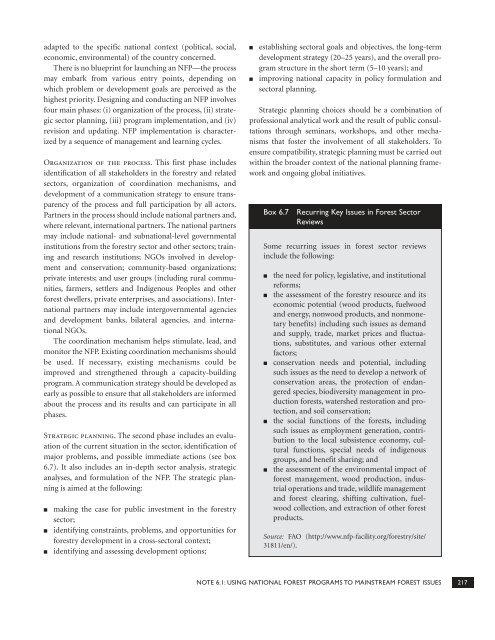Forests Sourcebook - HCV Resource Network
Forests Sourcebook - HCV Resource Network
Forests Sourcebook - HCV Resource Network
Create successful ePaper yourself
Turn your PDF publications into a flip-book with our unique Google optimized e-Paper software.
adapted to the specific national context (political, social,<br />
economic, environmental) of the country concerned.<br />
There is no blueprint for launching an NFP—the process<br />
may embark from various entry points, depending on<br />
which problem or development goals are perceived as the<br />
highest priority. Designing and conducting an NFP involves<br />
four main phases: (i) organization of the process, (ii) strategic<br />
sector planning, (iii) program implementation, and (iv)<br />
revision and updating. NFP implementation is characterized<br />
by a sequence of management and learning cycles.<br />
Organization of the process. This first phase includes<br />
identification of all stakeholders in the forestry and related<br />
sectors, organization of coordination mechanisms, and<br />
development of a communication strategy to ensure transparency<br />
of the process and full participation by all actors.<br />
Partners in the process should include national partners and,<br />
where relevant, international partners. The national partners<br />
may include national- and subnational-level governmental<br />
institutions from the forestry sector and other sectors; training<br />
and research institutions; NGOs involved in development<br />
and conservation; community-based organizations;<br />
private interests; and user groups (including rural communities,<br />
farmers, settlers and Indigenous Peoples and other<br />
forest dwellers, private enterprises, and associations). International<br />
partners may include intergovernmental agencies<br />
and development banks, bilateral agencies, and international<br />
NGOs.<br />
The coordination mechanism helps stimulate, lead, and<br />
monitor the NFP. Existing coordination mechanisms should<br />
be used. If necessary, existing mechanisms could be<br />
improved and strengthened through a capacity-building<br />
program. A communication strategy should be developed as<br />
early as possible to ensure that all stakeholders are informed<br />
about the process and its results and can participate in all<br />
phases.<br />
Strategic planning. The second phase includes an evaluation<br />
of the current situation in the sector, identification of<br />
major problems, and possible immediate actions (see box<br />
6.7). It also includes an in-depth sector analysis, strategic<br />
analyses, and formulation of the NFP. The strategic planning<br />
is aimed at the following:<br />
■<br />
■<br />
■<br />
making the case for public investment in the forestry<br />
sector;<br />
identifying constraints, problems, and opportunities for<br />
forestry development in a cross-sectoral context;<br />
identifying and assessing development options;<br />
■<br />
■<br />
establishing sectoral goals and objectives, the long-term<br />
development strategy (20–25 years), and the overall program<br />
structure in the short term (5–10 years); and<br />
improving national capacity in policy formulation and<br />
sectoral planning.<br />
Strategic planning choices should be a combination of<br />
professional analytical work and the result of public consultations<br />
through seminars, workshops, and other mechanisms<br />
that foster the involvement of all stakeholders. To<br />
ensure compatibility, strategic planning must be carried out<br />
within the broader context of the national planning framework<br />
and ongoing global initiatives.<br />
Box 6.7<br />
Some recurring issues in forest sector reviews<br />
include the following:<br />
■<br />
■<br />
■<br />
■<br />
■<br />
Recurring Key Issues in Forest Sector<br />
Reviews<br />
the need for policy, legislative, and institutional<br />
reforms;<br />
the assessment of the forestry resource and its<br />
economic potential (wood products, fuelwood<br />
and energy, nonwood products, and nonmonetary<br />
benefits) including such issues as demand<br />
and supply, trade, market prices and fluctuations,<br />
substitutes, and various other external<br />
factors;<br />
conservation needs and potential, including<br />
such issues as the need to develop a network of<br />
conservation areas, the protection of endangered<br />
species, biodiversity management in production<br />
forests, watershed restoration and protection,<br />
and soil conservation;<br />
the social functions of the forests, including<br />
such issues as employment generation, contribution<br />
to the local subsistence economy, cultural<br />
functions, special needs of indigenous<br />
groups, and benefit sharing; and<br />
the assessment of the environmental impact of<br />
forest management, wood production, industrial<br />
operations and trade, wildlife management<br />
and forest clearing, shifting cultivation, fuelwood<br />
collection, and extraction of other forest<br />
products.<br />
Source: FAO (http://www.nfp-facility.org/forestry/site/<br />
31811/en/).<br />
NOTE 6.1: USING NATIONAL FOREST PROGRAMS TO MAINSTREAM FOREST ISSUES 217

















